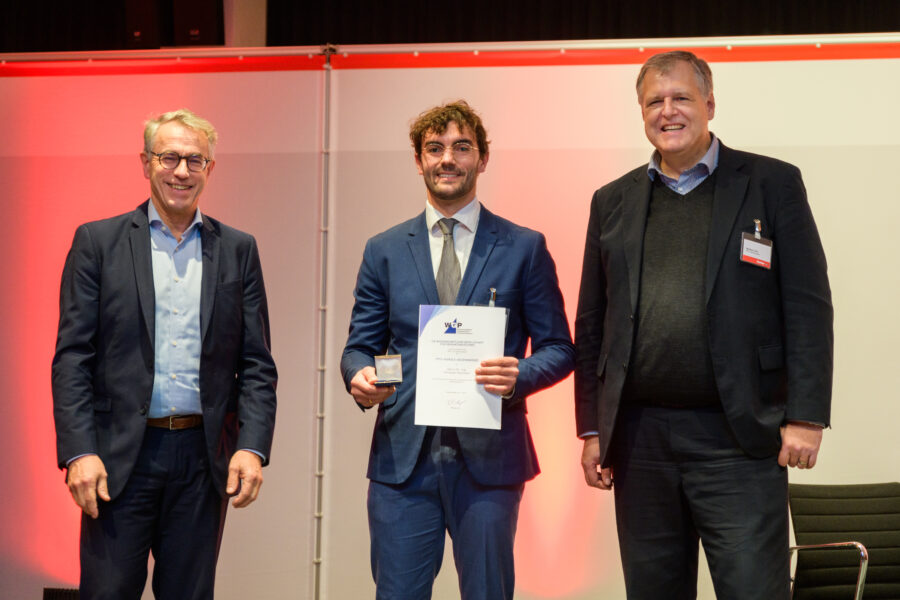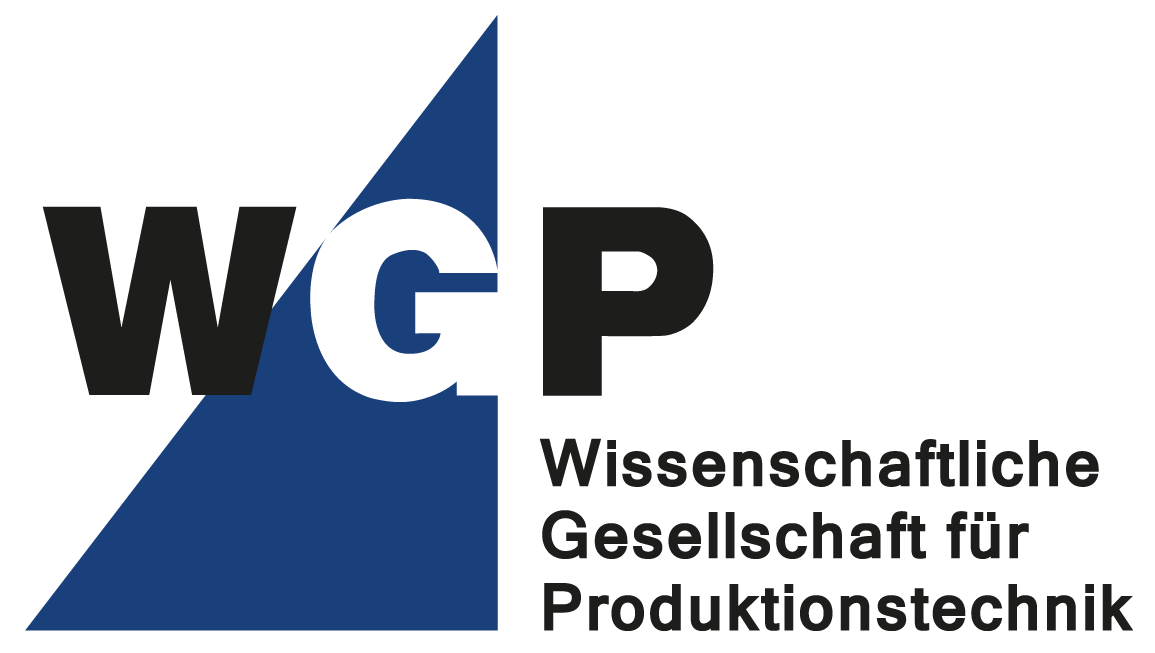
Hamburg, December 11, 2023 – Dr. Christoph Hartmann from the Chair of Forming Technology and Casting (utg) at the Technical University of Munich received the prestigious Otto Kienzle Commemorative Coin at the WGP Annual Congress. In Freudenstadt, the 71 professors of production engineering presented the young scientist with the coin for his pioneering research in forming technology. Among other things, his diverse work has initiated a paradigm shift in the detection of material deformation and cracks. In addition to his work on hybrid modeling, he is also dedicated to the hydrogen technologies of tomorrow.
The hallmark of Hartmann’s research is his transdisciplinary approach. He combines modern mathematical tools and data-based methods with physical operating principles, harmonizes them with the technical conditions and applies them to complex real-world processes. In short, he takes digitalization and artificial intelligence a step further and adapts them to engineering issues. This approach has brought Hartmann a whole series of astonishing successes and prizes.
Nevertheless, the current award is of particular importance to the young Munich native: “I am very honored to be visible in the large community of production engineers. However, my research would not have been possible without support, especially from my doctoral supervisor Prof. Wolfram Volk. It takes trust and encouragement to break new ground in a creative process.”
The dissertation describes a paradigm shift
The interdisciplinary view of mathematical methods from the field of computer vision led Hartmann to his innovative use of the Optical Flow Method (OFM). In his work, the 33-year-old replaced the usual optical methods for recording deformation processes.
The local block-matching and correlation methods used to date have significant deficits in the analysis of gradients and rates (e.g. strain rates) and in dealing with discontinuities (e.g. cracks). In contrast, the OFM formulates a global optimization problem in order to analyze deformation processes robustly and with a high degree of spatial and temporal detail. “With Christoph Hartmann’s methodology, it is now possible for image sequences in general to precisely and accurately capture higher partial derivatives of the movement, and to do so robustly against environmental influences and measurement noise and without complex sample preparation or the additional application of artificial evaluation patterns,” specifies his doctoral supervisor Volk, who heads the Chair of Forming Technology and Foundry Engineering (utg) at the Technical University of Munich. This enables material deformation processes to be analyzed in a new way, allowing theoretical explanatory approaches to be validated and verified, for example.
The potential applications of the methodology are of a general nature and go far beyond the challenging analysis of deformation processes during shear cutting, which the prizewinner examined in his doctoral thesis. It is therefore no wonder that there is broad international interest in this new approach.
Hybrid modeling as a core topic
“At the beginning, I thought about whether I should study mathematics or mechanical engineering – but I made the right decision,” emphasizes the young production engineer. “Nevertheless, it is extremely helpful to incorporate mathematical and physical approaches into engineering – for example, to gain a better understanding of the problem structure and use it as a starting point for optimizing production processes.”
His current core topic at the Munich utg is hybrid modeling in particular. “In general, I want to combine data-driven methods with engineering modeling approaches in a meaningful way, in other words, to combine the best of mathematics and information technology with engineering,” says Hartmann. His transdisciplinary approaches have also met with keen interest at international conferences.
Paving the way for hydrogen technologies
The researcher also thinks beyond the traditional issues of production technology. At utg, he is currently setting up the “Cryogenic material testing and application” department. “This area is intended to provide testing and production technology solutions for problems in the field of hydrogen storage and transportation,” says Hartmann, looking to the future. And this is already within reach, as test benches are to be installed and connected on site by the end of next year, with which materials can be tested for their hydrogen permeability, for example. “Hydrogen is the smallest of all molecules and also has a very low density under standard conditions, which makes it difficult to store. As part of our projects, we are researching how storage systems can be realized in large-scale production, for example for hydrogen-powered trucks. On the other hand, we are investigating the leakage of hydrogen from storage systems under different temperature and load conditions for aerospace applications. This is done in close cooperation with partners from research and industry.”
Focus on the world’s first large-scale production
Even archaeologists are interested in Hartmann’s research. For a long time, experts in the history of coinage were unable to explain how the first known large-scale production took place: the coinage of the Romans. “The emperors had to satisfy their numerous legionaries with a corresponding quantity of coins. But for a long time it was unclear how their production worked. Were they minted hot, warm or cold?” explains Hartmann with amusement. “Our metallographic and experimental analyses have shown that they were minted warm, i.e. below the recrystallization temperature.” This news found its way into an archaeological journal and contact with numismatists has not been broken off since.
Start-ups from diverse activities
The 33-year-old researcher has many successful experiences to report. For example, his start-up, which he co-founded in 2020. 3deviation GmbH creates data analyses, process data handling and modeling from existing process and sensor data for companies. This service arose from a preliminary study with the BMW Group on series production using additive processes. The result was a data-based methodology for implementing robust series processes without the detour via process simulations.
Another project in which Hartmann was involved is aCar mobility. This has also developed into a start-up, Evum Motors GmbH, which offers electric commercial vehicles with all-wheel drive. “The original aim of the aCar mobility project was to create capacity for production, assembly and repairs in urban regions,” he sums up. “Part of the added value could even be located in remote parts of the world.”
Diversity at universities often thought of too narrowly
As if that wasn’t enough, the busy production engineer is also involved in the Diversity Board at the Technical University of Munich. “I try to implement a broader understanding of diversity,” he emphasizes, “because unfortunately the topic is often reduced to simply measurable variables such as the proportion of women. But there is much more to the term: different cultural backgrounds, age groups or even different educational backgrounds. At universities, we have to be open to different educational paths, including people who have found their way to university after vocational training, for example.”
As comprehensive as this all sounds, he still has time for his wife and three young children. He has already taken parental leave twice, and for his two-month research stay in Korea, he took the family with him without further ado. Not forgetting the parent-child association in which he and his wife are involved. They are involved twice every ten weeks when twelve little kids want to be kept busy for three hours.
How does Hartmann see his future? “At the moment, I see myself as a researcher – but increasingly also as a teacher. I’m becoming more and more aware that we need to actively promote young talent in our field – and that includes good teaching and training in particular.”
Download:
Image 1: Presentation of the Otto Kienzle commemorative coin to Dr. Christoph Hartmann, 23 November 2023 (from left to right: Prof. Mathias Liewald, Head of the Institute of Forming Technology Stuttgart, Dr. Christoph Hartmann, Prof. Wolfram Volk, Head of the Chair of Forming Technology and Foundry Engineering Munich) Source: Fotoatelier Ebinger
Image 2: Dr. Christoph Hartmann, Source: Letzel
Image 3: Crack progression during shear cutting, source: Christoph Hartmann
